“Daring to set boundaries is about having the courage to love ourselves, even when we risk disappointing others.” - Brené Brown
Rather than bringing tidings of comfort and joy, it’s easy to feel pressured, anxious and stressed out.
One way to help navigate the trickier side of the season can be to set some boundaries.
Boundaries help us enhance our self-esteem, improve our relationships, and manage our feelings of overwhelm - the benefits are plentiful and necessary for our peace of mind.
Yet the word “boundary” itself can still be misleading. We tend to think of it as fence to keep things out, or as a divide between us and others. In fact, it’s helpful to think of boundaries as gates or connecting points, providing healthy rules for navigating relationships.
So, how to set boundaries?
Here five tips to get you started.
1. Listen to Yourself
Begin by listening to yourself.
What’s important to you? What are your needs? Are you feeling any resentment, anger or discomfort? These feelings are a sign of poor boundaries.
We recommend journaling through these questions to help stimulate some insights.
2. Learn to Say ‘No’
Give yourself permission to say ‘no’.
You don't need to overexplain, debate or defend yourself to anyone.
Saying no helps you manage your current schedule. You become more efficient, as you’re not stretching yourself too thin. It also makes what you say yes to become more meaningful.
Saying no can feel uncomfortable at first. Read this article for more tips on how to comfortably say no. You'll also find some helpful reminders in our free My Rights Poster (PDF download).
3. Allow Room for Flexibility
Know that boundaries can be flexible.
It’s a balance: too rigid, you risk isolation; too soft, you risk exploitation.
It comes back to applying Step 1 and knowing the situation before you. You’ll wobble - and that’s okay! Perfection is not what we’re seeking here, but progress towards healthier living.
4. Use ‘I’ Statements
‘I’ statements are clear and non-negotiable, and allow you to express yourself without blaming, threatening or misleading others.
As a consequence, you’re less likely to provoke a defensive response in the listener.
Here’s an example ‘I’ statement:
I feel ____ when _____ because ______________. What I need is ___________________.
If you struggle with knowing exactly how to phrase things, look into Nonviolent Communication (NVC). It provides an easy step-by-step framework for communicating well. You'll find some practical NVC worksheets included in our Mental Wellbeing Toolkit.
5. Set Consequences
Consequences help you stick to the boundaries you’ve set. They also help others understand the importance of them. It can be as simple as leaving the room, ending the conversation, or hanging up the phone.
Consequences help keep the boundary clear.Here’s an example:
“It’s not okay for you to keep making comments about my weight. If you don’t stop it, I’ll leave the room.”
As Brené Brown says, “When we fail to set boundaries and hold people accountable, we feel used and mistreated.”
You must stick to your guns!Summary
To see the impact of setting boundaries, repeat these five steps again and again:
- Listen to yourself - tune into your feelings and needs
- Get comfortable saying no
- Allow room for flexibility
- Use 'I' statements
- Set consequences for when your boundaries are violated
We learn by repetition, so allow yourself room to practice and to make imperfect progress.
Set yourself a standard of progress rather than perfection, leaving room for a little bit of grace for yourself and for others.It might feel uncomfortable at first, but rest assured that it gets easier over time.
Poor boundaries lead to resentment, anger and burnout. Healthy boundaries help you honour your needs, prevent unwanted behaviour, and foster the behaviour you want.
Like any new skill, setting boundaries takes practice. Keep going, and be kind to yourself when you slip up. You've got this!
A Toolkit to Help You Become More Assertive
Research shows that self-help materials are often enough for people to overcome mild to moderate mental health difficulties without professional support.
Our self-guided program includes tools from NVC, DBT, ACT and more, so you can discover what works best for you. Check out The Mental Wellbeing Toolkit today – it's "like 10 therapy sessions in one."

About Emma
Emma Woodcock is a writer and trainee counsellor who has worked with homeless young people as well as people suffering with anxiety and grief. She currently lives in Melbourne, Australia. Visit her website www.emmawoodcock.com.Pin For Later




